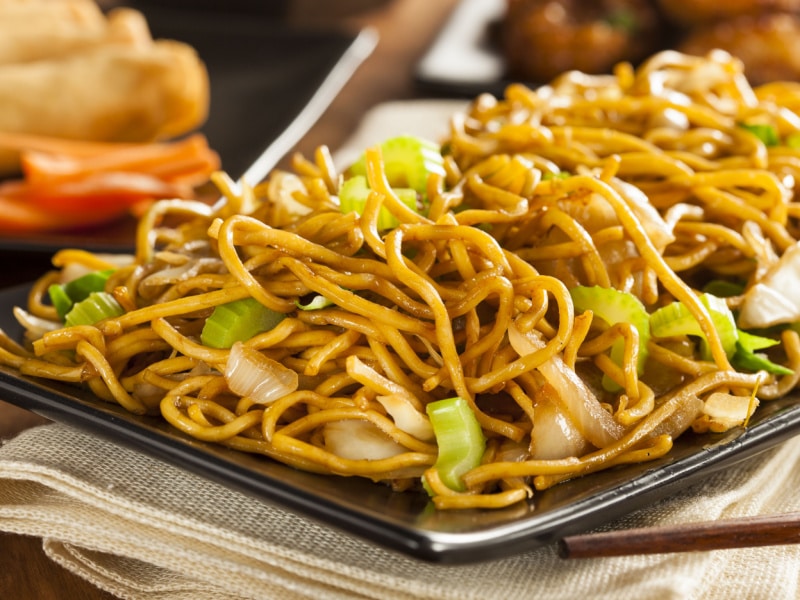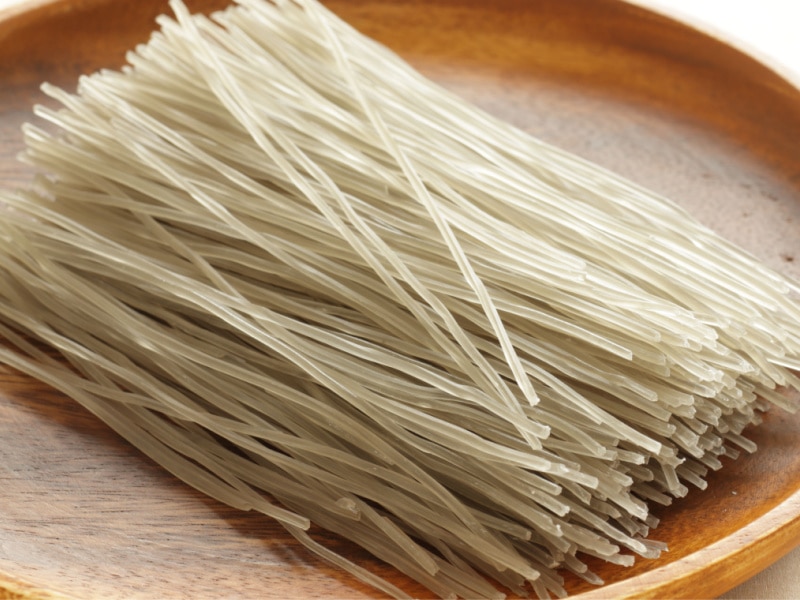There are so many types of Asian noodles out there! But these are some of my favorites.
And I think you’ll love them, too!

Best Types of Asian Noodles
Are you a big fan of Asian cuisine? And noodles? Then, you’re in for a treat!
Because this article is all about The Noods.
From glossy mung bean threads to chewy yaka mien, noodles are vital in Asian cuisine.
These twisty, totally slurpable noodles win over our hearts (and tummies) with every bite.
From soul-warming soups to vibrant stir-fries, they’re everywhere. And I’m not mad about it.
Grab your chopsticks and dive in!
1. Ramen

- Hailing from: Japan
- Main ingredient: Wheat
Get ready to meet the rock stars of Japanese cuisine, Ramen noodles.
Ramen noodles contain wheat flour, water, salt, and a special alkalizing agent. Together, these ingredients create a delightful springy noodle.
The most widely available ramen variety is instant ramen. They are pre-cooked, fried, and fashioned into a nifty brick shape.
2. Soba

- Hailing from: Japan
- Main ingredient: Buckwheat
Soba noodles are a beloved Japanese staple. They have a nutty, earthy flavor and a distinct dark hue that sets them apart.
Buckwheat is a seed that makes soba noodles high in protein, fiber, and gluten-free.
The real magic of soba noodles lies in their adaptability. They can charm your palate, whether served piping hot or refreshingly cold.
3. Udon

- Hailing from: Japan
- Main ingredient: Wheat
Next up, Udon. These Japanese-born noodles have a robust, thick physique, made predominantly from wheat.
Udon noodles are famous for their chewy, dense texture. And they are delectable, whether served fresh, frozen, or dried.
You will often see them basking in hot, flavorful broths. It’s safe to say they have a knack for soaking up the soup’s flavors.
If you are eager for a taste, try a bowl of Yaki Udon. It is a stir-fry spectacle that showcases the udon’s unique texture.
4. Lo Mein

- Hailing from: China
- Main ingredient: Wheat
Lo Mein noodles are a tactile delight. Each noodle offers a doughy, tender bite. En masse, the texture is divine.
They love to party with thick, glossy sauces. Which only benefits us, as sauce clings to every inch of the noodle surface. Delectable.
Whether you encounter Lo Mein fresh or dried, their signature soft texture is a constant.
If you’ve ever ordered Chinese takeout, you have likely had these noodles.
There’s a reason they’re so popular!
5. Rice Vermicelli

- Hailing from: All over Asia.
- Main ingredient: Rice.
These ultra-thin, rice-crafted strands are super popular all over Asia.
They adapt to every cuisine they touch. You’ll see them in Chinese stir-fries, Vietnamese spring rolls, and Thai soups. And more!
When cooked in water, they turn soft and chewy. A quick deep-frying session transforms them into crispy treats.
6. Rice Sticks

Hailing from: All over Asia.
Main ingredient: Rice.
Meet the ever-popular Rice Sticks. They are straight, flat, dried rice noodles. Hence the name.
They sell Rice Sticks dried and they come in a trio of sizes. Each size- thin, medium, and wide- caters to different recipes.
Once cooked, they take on a firm, chewy texture, perfect for various dishes.
7. Chow Mein

- Hailing from: China.
- Main ingredient: Wheat.
Say hello to the superstar of Chinese cuisine – Chow Mein. Its name? It translates to “pan-fried noodle“.
These guys sell in their dried and parboiled form, making them a real time saver. They are a touch thicker than vermicelli and oh-so-satisfying.
Wondering how to cook Chow Mein noodles?
It’s a cinch!
They’re already parboiled, so you can toss them straight into your stir-fry wok. No need to boil first.
You can also deep-fry Chow Mein until crispy. It makes a fantastic base for Cantonese dishes.
8. Naengmyeon

- Hailing from: Korea.
- Main ingredient: Various starches.
Naengmyeon is a fascinating type of Korean noodle.
It’s prepared from a unique blend of ingredients, including flour and buckwheat. Plus, the starches from sweet potato and arrowroot.
These noodles showcase a dense, resilient, and slightly gelatinous texture.
Serve them chilled in a flavorful broth. Adorn the dish with vegetables and thin slices of meat or fish. Now, that’s a traditional meal!
Try them in Bibim Nengmyun, a testament to Korea’s delicious cuisine.
9. Somen

- Hailing from: East Asia.
- Main ingredient: Wheat.
Somen is a close relative of soba but with its own unique charm.
Producers make these noodles with oil-enriched wheat flour. This results in a delicate, silky texture that’s hard to resist.
In Japan, they serve Somen chilled, with a side sauce for dipping.
However, they’re also fabulous in hot soups, offering a delightful contrast.
In South Korea, they go by the name Somyeon.
10. Lamian

- Hailing from: China.
- Main ingredient: Wheat.
Lamian are hand-pulled wheat-noodles known for their impressive length.
Buy these noodles are fresh. You really can’t find a dried version.
Fun fact, Lamian are the stars of Cháng Shòu Miàn (Longevity Noodles). In Lunar New Year celebrations, these noodles signify a wish for a long and happy life.
Be careful not to break them!
Taste the tradition and skillful art of noodle-pulling with a dish of Lamian noodles.
The delightful texture and symbolism will make your meal an unforgettable one!
11. Shirataki

- Hailing from: Japan.
- Main ingredient: Konjac.
Have you heard of Shirataki? It’s a unique type of noodle derived from konjac, a yam native to Japan.
These round, semi-transparent noodles are full of fiber and are devoid of calories.
Shirataki is quite popular among “low-carb” food enthusiasts.
Traditionally, you can serve them like other rice-based noodles in Japan. You’ll find them in warming soups and vibrant stir-fries.
12. Wonton Noodles

- Hailing from: China.
- Main ingredient: Wheat.
Wonton Noodles are popular because of their thin, elastic texture.
They craft wonton noodles from the same dough as the famed wonton wrappers.
They sell these noodles fresh. And people widely enjoy them in nourishing and comforting soups.
You’ll find their signature springiness a delightful contrast to the broth. Grab a bowl of Cantonese Wonton Noodle Soup and try it for yourself!
13. Silver Needle

- Hailing from: China.
- Main ingredients: Rice and tapioca starch.
Silver needle noodles are short noodles. Thanks to rice and tapioca starch, they have tapering ends and a firm, chewy texture.
Chinese cuisine cherishes these noodles. And they are popular in stir-fries and soups.
14. Japchae

- Hailing from: Korea.
- Main ingredients: Sweet potato starch.
Japchae is a Korean classic. These noodles, usually dried in hefty plastic bags, are made from sweet potato starch.
But you might spot them fresh in the fridge section of Korean grocers.
The noodles have a unique greyish, semi-transparent look and a rubbery, slippery feel.
Now, Japchae is not just the noodle; it is the dish’s name! These chewy treats are perfect for stir-frying with veggies and beef.
Or how about adding some to your soups and stews for extra texture?
15. Yaka Mien

- Hailing from: China
- Main ingredients: Wheat.
With the nickname “Chinese spaghetti,” Yaka Mein is the Western cousin of Chinese wheat noodles.
Yaka Mein is like lo mein but with a thicker, chewier texture.
Look for these noodles in your local Chinese restaurant or the supermarket noodle aisle.
They come in soft (refrigerated or frozen) and dried varieties.
Cooking Yaka Mien is all about soups. Once cooked, they turn yellow and boast a hearty texture similar to udon. Or thick spaghetti (thus, the nickname).
16. Mung Bean Threads

- Hailing from: China and East Asia.
- Main ingredients: Mung bean starch paste.
Mung bean threads are regular in many Thai, Chinese, and Vietnamese recipes.
These glass noodles are made with mung bean starch paste and are very thin. They come in small, adorable bundles that resemble angel hair pasta.
They sometimes come as sheets, known as “fan pei“ or “glass paper”.
Got a minute?
That’s all you need to transform these threads. Soak them in hot water and watch them turn clear, soft, and rubbery. It’s a wonderful texture!
Asian Noodles vs. Italian Pasta
So, what’s the difference between Asian noodles and Italian pasta? They might seem like long-lost twins at first glance. But they have some very unique traits!
Italian pasta aims for that al dente bite.
But Asian noodles do their own thing. Some are tender, and others pack a firm punch. Some are chewy.
And others, like ramen, have a springy resistance that’s a joy to munch on.
And talk about variety! There are rice, yam, mung bean, seed, and wheat flour variations of Asian noodles. And that’s just the tip of the iceberg.
And pasta normally comes from durum wheat (semolina).
Asian noodles use a vast array of ingredients for exciting flavors and textures.
So, swapping Italian pasta for Asian noodles is not the best move.
Where to Buy Asian Noodles
Shopping for Asian noodles can feel like a treasure hunt, right? In Asian grocery stores, they are usually grouped by country.
But this is the tricky part- you’ll find the same noodles sporting different names.
They will even have unique packaging. And often, they hide in various corners of the store.
They could be dried, fresh, refrigerated, or frozen.
If you’re on a noodle quest, an Asian grocer is your best bet. But if there’s none nearby, online shopping has your back.
Pick an authentic Asian brand for the best quality, flavor, and texture.
How to Cook and Store Noodles
The way to cook Asian noodles changes depending on the noodle type.
Some noodles, like rice noodles, only need a quick dip in boiling water.
Others might not need a hot bath at all. So, the rule of thumb is to make friends with the packaging instructions.
Storing noodles also depends on their type.
Dried noodles like to hang out in cool, dark spots like the pantry. Keep fresh noodles in their original packaging in the fridge.










